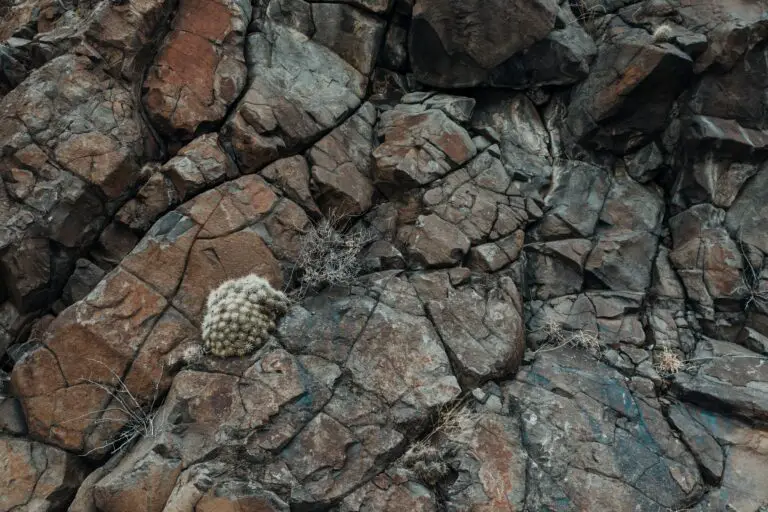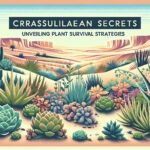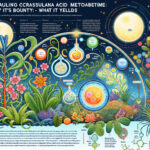Introduction to Crassulacean Acid Metabolism
Delve into the world of Crassulacean Acid Metabolism (CAM), a remarkable survival strategy used by certain succulent plants in arid conditions. Understand what the term ‘crassulacean’ refers to and how it relates to the overall mechanism of CAM. This photosynthetic marvel not only exemplifies the resilience of these plants but also highlights the fascinating adaptability of life on Earth.

Imagine a landscape bathed in the relentless sun, where rainfall is but a rare luxury. Here, plants like the jade and other succulents thrive, not just in spite of these harsh conditions, but because of an ingenious method they employ, synonymous with the term ‘crassulacean.’ These plants exhibit CAM, allowing them to preserve precious water by opening their stomata at night instead of during the day when evaporation rates are high.
Take the Crassula ovata, commonly known as the jade plant. It’s an archetype of crassulacean resilience, perfectly illustrating the CAM strategy. By night, this succulent opens its stomata, taking in carbon dioxide and storing it as malic acid. Come daylight, the stomata close, and photosynthesis proceeds with the stored carbon, minimizing water loss and maximizing the efficiency of the water it has. It’s a beautiful dance between survival and physiology that paints a vivid picture of life’s tenacity.
The Science Behind CAM Photosynthesis
In the beguiling world of botanical wizardry, there’s a process that stands out not just for its exotic title but for its remarkable knack for survival—Crassulacean Acid Metabolism, more commonly known as CAM photosynthesis. This isn’t just another plant process; it’s the secret survival strategy of some of the world’s most resilient flora.
While many of us are acquainted with the classic photosynthesis—the magical transformation of sunlight, CO2, and water into sugar and oxygen—CAM plants take a detour from this beaten path. Dwelling in arid conditions, these plants have tweaked the formula to minimize water loss while maximizing energy gain. It’s like they’re playing the plant equivalent of ‘Survivor’ and boy, do they nail it!
A Nighttime Affair: CAM’s Unique Twist
The CAM pathway is a nocturnal escapade. When the moon takes the sky’s stage, CAM plants open their stomata—the tiny mouth-like openings on their leaves— to gulp in the CO2 and store it as malic acid, all while keeping water firmly locked in. Come sunrise, when other plants are just rolling up their sleeves to start the day, CAM-equipped greenery already has a stockpile of carbon dioxide ready to power through photosynthesis.
Imagine a cactus in the scorching desert or an orchid lounging in the canopy’s shade—they don’t guzzle water like their thirstier C3 and C4 counterparts. Instead, they’ve mastered the art of sipping it slowly, making the most of their sip to unfurl their metabolic magic. This nightly habit of carbon fixation is what sets the CAM photosynthesis apart and gives these plants their extraordinary drought tolerance.
To get a closer look at the intricate dance of CAM photosynthesis, feast your eyes on this enlightening video:
By now, you’re probably marveling at how these plants cleverly navigate their harsh habitats. CAM photosynthesis isn’t simply a cool party trick in the plant kingdom; it’s a critical adaptation that has enabled a diverse array of species to thrive in some of Earth’s most challenging environments. So the next time you encounter a succulent or a bromeliad, take a moment to appreciate the silent yet spectacular science that’s ticking away inside their leaves, a true testament to the wonders of evolutionary innovation.
Crassulaceae Family and CAM
Imagine a group of plants that devised a remarkable strategy to survive in arid landscapes where most would wither and fade. This is the story of the Crassulaceae family, a remarkable lineage known for pioneering a unique photosynthetic adaptation known as Crassulacean Acid Metabolism, or CAM for short. Picture these plants as the original innovators of a water-saving technique that’s been akin to hitting the ecological jackpot, allowing them to thrive where others barely survive.
Let’s meet the Crassulaceae family—the illustrious group where CAM was first noticed by inquisitive botanists. These aren’t your average backyard blooms but are instead hardy succulents, like the jade plant and the sedum, who zealously guard every drop of water they gather with their fleshy leaves. But wait, the plot thickens! CAM isn’t just the secret handshake of this specific family.

Stand by for a twist—because CAM is a marvel that’s made its way into other plant families as well. It’s not just an exclusive club for the Crassulaceae. Other succulents and cacti have caught on to this technique, each adapting it in their unique way. Imagine the cacti of the vast desert landscapes, their ribbed bodies swelling with reserved water, all thanks to CAM. They’re like botanical camels, their humps brimming not with fat but with stored water and the ingenuity of CAM.
This innovative process is not just about being thrifty with water; it’s an all-night affair. While most plants open their stomata during the day to absorb carbon dioxide, CAM plants throw a curveball by doing this at night. This is a game-changer—by keeping their stomata closed during the scorching day, they significantly lower water loss, which is a lifesaver in hot, dry climates.
Think of it as a nocturnal dance—a slow, deliberate rhythm that these plants follow under the moonlight, absorbing CO2 and storing it as an acid until sunshine beckons. Then, with the first light, they convert the stored acid back into carbohydrates for growth, all the while keeping their precious water untouched. It’s a masterclass in resource management, one that’s ensured their survival in demanding environments.
Adapting CAM: A Cross-Family Affair
The ingenuity of CAM caught on because it’s not just a clever trick but a vital adaptation for survival. This isn’t a proprietary technique; rather, it’s been shared across the botanical community, spanning different families. From orchids to bromeliads and agaves, a diverse array of plants has adopted CAM to make the most of their challenging habitats.
These plants have turned the tables on what would typically be harsh living conditions. Each one is a testament to the power of evolution and adaptation—proof that even in the plant world, innovation is the key to overcoming obstacles. They’ve become experts at doing more with less, a lesson we could all learn from in our increasingly resource-conscious world.
As we delve deeper into the secrets that these plants hold, we can’t help but marvel at the cleverness of nature. The Crassulaceae family, along with their fellow CAM practitioners, showcases resilience and ingenuity worthy of emulation. Their story isn’t just about survival; it’s about thriving against the odds, an inspiring ode to life’s extraordinary ability to adapt and flourish.
Environmental Benefits and Adaptations of CAM Plants
Crassulacean Acid Metabolism, or CAM for short, is a bit of botanical wizardry that plant species in arid environments have evolved to employ. This physiological process is akin to a survival kit for plants in drought-prone terrains where water is as scarce as a cloud in a desert sky. The ingenuity of CAM plants lies in their ability to minimize water loss while still performing the essential task of photosynthesis—quite the enviable adaptation for creatures rooted in place!

Imagine a sweltering day when every droplet of water counts. CAM plants choreograph their water usage by opening their stomata at night to take in carbon dioxide, rather than during the day like most plants. This nocturnal activity allows them to conserve water by reducing evaporation under the hot sun. In essence, these plants have mastered the art of timing, syncing their routine with the rhythm of the environment to make the most of limited resources.
The Ecological Role in Native Habitats
In their native habitats, CAM plants are true environmental champions. Take, for instance, a cactus in the scorching Mojave Desert or an agave perched on a rocky Mexican outcrop—both are beacons of life in landscapes where few organisms dare to take root. By hoarding water efficiently and providing sustenance to other species, these plants are cornerstones of their ecosystems.
Their drought-resistant nature also plays a pivotal role in soil stabilization. With their roots firmly entrenched, CAM plants prevent soil erosion, effectively acting as nature’s anchors in regions susceptible to the ravaging effects of wind and water erosion. Their presence is crucial to maintaining the fragile balance of their ecosystems and supporting a diversity of life ranging from tiny insects to majestic mammals seeking reprieve in the shade of their boughs.
It’s not just about survival; it’s about thriving against the odds, and CAM plants provide a blueprint for resilience. By studying these botanical wonders, we unlock clues to sustainable living in arid zones and how to cultivate crops that could withstand the growing challenge of global climate change. Every drop saved by these plants is a testament to life’s incredible capacity to adapt and persevere.
Cultivating CAM Plants: Care and Tips
If you’re keen to green your space with succulents, or you’re a cacti connoisseur looking for a new challenge, the world of CAM plants might just be your next horticultural adventure. CAM, or Crassulacean Acid Metabolism, is like the secret agent of photosynthesis. These hardy plants have evolved a unique way to thrive in the driest and most sun-scorched habitats. Here’s your guide to getting those CAM plants to flourish in your very own botanical nook.
The Right Soil for Success
The foundation of any plant’s health is the soil it calls home. For CAM plants, think fast-draining and gritty. A mix of potting soil with perlite, coarse sand, or volcanic rock gives roots the breathable, desert-like environment they crave. Just like a well-mixed cocktail sets a swanky evening into motion, the right soil mix sets your CAM plants up for a toast-worthy growth.
Watering Wisdom
Now let’s talk aqua. These plants are the camels of the flora world – they store water in their thick leaves, so overwatering is a bigger faux pas than wearing socks with sandals. Picture this: you’re doling out water like fine wine at a gala, only indulging your plants when the soil is as dry as a seasoned comedian’s wit. Bottom line, soak them thoroughly, then allow the soil to completely dry out before even thinking about a refill.
Sunlight: More Is More
Sun worshippers by nature, your CAM buddies will soak up more rays than sunbathers at the beach. These are not your delicate, shade-seeking ferns. Position them where they’ll catch as many Z’s under the sun as possible – south-facing windows are their idea of paradise. And don’t worry about getting them sun-block. These sunbathers are built for endurance beneath those blazing rays.

Keep these tips in mind and your CAM plants will be more than just surviving—they’ll be strutting their stuff. With their striking silhouettes and low-maintenance attitudes, they’re perfect for adding that ‘living art’ vibe to your room or garden. Just remember, like any good relationship, it’s all about understanding their needs and quirks. Treat them right, and you’ll have a loyal green companion for years to come.
Impact of Climate Change on CAM Species
Crassulacean Acid Metabolism, or CAM, is no mere botanical curiosity—it’s a survival mechanism honed by evolution, allowing plants to thrive in arid conditions where others surrender. These botanical superstars open their stomata at night to fix CO2, conserving precious water under the scorching sun. But what happens when even the desert’s harsh clime becomes unhinged by climate change?
Climate change presents a formidable challenge, yet for CAM species, it’s a nuanced narrative. With a warming planet and more frequent droughts, these plants, like the plucky Portulacaria afra or ‘elephant bush’, might just be gearing up for an ecological takeover. Their exceptional water-use efficiency grants them a tenacity that could turn today’s arid wastelands into tomorrow’s CAM sanctuaries.
Consider the succulent gardens of your local plant enthusiast—once a niche hobby, now a booming trend. As the globe warms, these drought-resilient species are not just surviving; they’re proliferating, whispering hints of a future where CAM plants could become commonplace beyond the confines of curated collections.
Yet let’s not don our rose-colored glasses too hastily. The adaptive prowess of CAM species doesn’t render them invincible. Ecosystems are intricate tapestries, and with climate change, some threads may unravel. It’s a biological balancing act, and while some CAM species might spread their roots far and wide, others could face new threats—exotic pests, habitat encroachment, or even too much of a ‘good’ thing.
Imagine, for a moment, the saguaro cacti of the Sonoran Desert standing like green sentinels against the sky. As temperatures soar, their endurance will be tested. Their survival is a testament to resilience and a warning—adaptation has its limits. The saguaro, and many like it, embody the silent struggle of CAM species in a changing climate.
To truly grasp the impact of climate change on these resilient survivors, let’s dive into a deeper understanding with some visual aid. This video explores critical insights into how climate change could shape the future distribution of CAM plants, providing a glimpse at the adaptability of nature’s marvels.
As the planet’s pulse quickens with climate change, CAM species stand at a crossroads. Will they march toward a greener horizon, or will they be caught in the crossfire of environmental extremes? This question echoes through the scientific community, urging further study and fostering hope that these desert denizens may hold crucial clues for plant survival in a warming world.
Frequently Asked Questions
Ever wondered how some plants can thrive in what seem like inhospitable environments, arid deserts, or rock crevices? Let’s delve into the ingenuity of crassulacean acid metabolism (CAM) and find out together how it gives these plants a winning edge.
What exactly is crassulacean acid metabolism?
At its core, crassulacean acid metabolism is a survival wizard’s trick up the leaf sleeves of some smart plants. By opening their stomata at night to absorb carbon dioxide and store it as malic acid, these plants can keep their pores tightly shut during the scorching day to conserve water—think of it as botanical night-time banking!
How do plants benefit from this nocturnal activity?
Imagine you’re in the desert, with a limited water supply. You’d ration it carefully, right? That’s what CAM plants do. By taking in CO2 at night, these plants lose less water and can photosynthesize during the day without opening their stomata—the ultimate hydration hack.
Are there any real-life champions of CAM?
Think of succulents, like the plump leaves of a jade plant or the thick skin of aloe vera. These plants are the poster children for CAM. They survive and thrive by banking carbon dioxide at night. It’s like creating a water-saving reservoir within their leaves, enabling them to flourish even in the land of the scorching sun.
Can CAM plants survive better than other plants?
It’s all about the right strategy for the right environment. In hot, dry places where water is more precious than gold, CAM plants have the upper hand. They’re like the camels of the plant world, hoarding their resources to make the most of a harsh landscape.

Is crassulacean acid metabolism a common trait?
CAM is pretty exclusive and found in only a fraction of plant species. But it’s a lifesaver for those that have it, granting them VIP access to ecosystems others can’t handle. While it’s not the norm, it’s a brilliant adaptation for survival.
Will learning about CAM change the way we farm?
Potentially, yes! By understanding and harnessing the strategies of CAM plants, we may develop crops that require less water. This could revolutionize farming in arid regions, making agriculture more sustainable and resilient against the backdrop of climate change.



